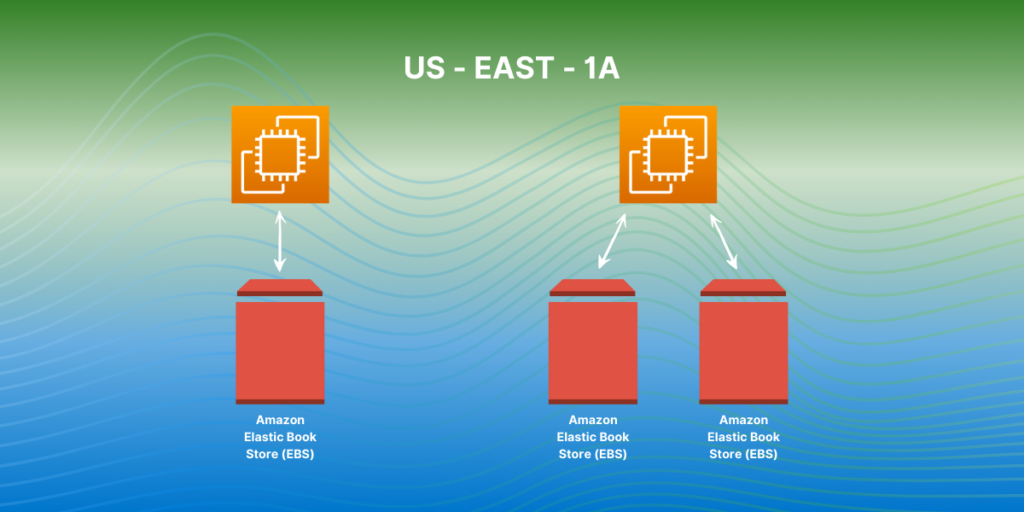Amazon EBS volumes (Elastic Block Store) is a high-performance, scalable block storage service from Amazon Web Services (AWS). It provides persistent storage volumes for Amazon EC2 instances, crucial for running applications and storing data in the cloud. EBS ensures low-latency, high-throughput data transfer for demanding applications.
Launched by AWS in 2008, EBS offers durable, reliable block-level storage for EC2 instances, addressing the need for persistent data storage in cloud environments. EBS has since added features like encryption, snapshots, and various volume types to meet different performance and cost needs.
EBS supports a wide range of use cases with high availability and durability through data replication within an Availability Zone. It offers multiple volume types, such as General Purpose SSD (gp2/gp3), Provisioned IOPS SSD (io1/io2), and Throughput Optimized HDD (st1), catering to different performance and budget requirements. EBS allows easy scaling of storage capacity and performance, with integrated backup solutions, encryption for data security, and seamless integration with other AWS services, making it essential for efficient and reliable cloud storage.
How Amazon EBS volumes work
Amazon EBS volumes offer high availability, durability, and the flexibility to scale, making them ideal for workloads that require stable and reliable storage. EBS volumes are designed to be highly available and reliable, with a wide range of performance options to suit different application needs.
To use an EBS volume, you first need to create it within the AWS Management Console. Once the EBS volume is created, it can be attached to any running EC2 instance. Here’s a step-by-step process on how EBS volumes can be attached to EC2 instances:
- Create an EBS Volume: Navigate to the “Volumes” section in the AWS Management Console, and click “Create Volume.” You can specify the type, size, and other settings based on your requirements.
- Attach the EBS Volume: After creating the EBS volume, select it and click on “Actions,” then choose “Attach Volume.” Select the relevant EC2 instance to which you want to attach the volume.
- Mount the Volume: Once the volume is attached, you need to mount it on the EC2 instance. Connect to the instance via SSH and use appropriate commands to format and mount the volume. For example, you can use lsblk to list block devices to mount the volume.

Attachments and Instances
EBS volumes are storage devices for Amazon EC2 instances, functioning as virtual hard drives with persistent block-level storage. Data on an EBS volume remains even after the EC2 instance is terminated.
Created independently from EC2 instances, EBS volumes can be attached to any EC2 instance in the same Availability Zone and can be detached and reattached as needed.
When attached to an EC2 instance, EBS volumes appear as block devices, like physical hard drives. Multiple EBS volumes can be attached to a single instance, allowing for data management flexibility and improved performance by distributing I/O across volumes.
Amazon EBS volumes can be backed up using snapshots, point-in-time copies that can create new volumes or restore data if lost.
Storage Types
- General Purpose SSD (gp2): Default EBS storage, balanced price and performance. Baseline 3 IOPS/GB, max 3,000 IOPS.
- Provisioned IOPS SSD (io1): For high-performance databases and I/O-intensive applications. Customizable IOPS, up to 64,000 IOPS per volume.
- Throughput Optimized HDD (st1): Ideal for frequently accessed, throughput-heavy workloads like big data and log processing. Low cost per GB, up to 500 MB/s throughput per volume.
- Cold HDD (sc1): Best for infrequently accessed data, such as backups. Lowest cost per GB, with a max throughput of 250 MB/s per volume.
Features of Amazon EBS Volumes
Amazon EBS volumes offers the following features and benefits:
- Multiple Volume Types: Choose from SSD-backed storage for transactional workloads and HDD-backed storage for throughput-intensive workloads to optimize performance and costs.
- Scalability: Dynamically adjust volume capacity and performance without downtime using Elastic Volumes.
- Backup and Recovery: Use EBS snapshots for data backup and quick restoration, as well as data transfer across AWS accounts, regions, or availability zones.
- Data Protection: Encrypt volumes and snapshots to secure data-at-rest and data-in-transit.
- Data Availability and Durability: io2 Block Express volumes provide 99.999% durability, with other volumes ensuring 99.8% to 99.9% durability. Data is replicated across multiple servers within an availability zone.
- Data Archiving: EBS Snapshots Archive offers a cost-effective storage tier for archiving snapshots for 90 days or more.
Amazon EBS is a highly versatile and integral component of AWS that provides scalable, high-performance block storage for EC2 instances. EBS volumes function as virtual hard drives, ensuring persistent data storage even after instances are terminated. They can be easily created, attached, detached, and reattached across EC2 instances within the same Availability Zone, offering users flexibility and control over their storage solutions.
Amazon EBS supports various volume types tailored to different performance and cost needs, including General Purpose SSD (gp2), Provisioned IOPS SSD (io1), Throughput Optimized HDD (st1), and Cold HDD (sc1). Each type offers distinct characteristics suitable for a range of workloads, from high-performance databases to long-term data storage.
Overall, Amazon EBS volumes is an essential service for users requiring reliable, flexible, and high-performance storage solutions within the AWS ecosystem, supporting a wide range of applications and workloads with its robust set of features and capabilities.
How to start with Amazon EBS?
Take the next step towards a more efficient and powerful cloud infrastructure. Reach out to us now and discover how CloudAvocado can transform your storage strategy with Amazon EBS.



